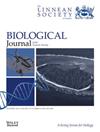Mitogenomics of a declining species, the Rio Grande silvery minnow (Hybognathus amarus), with boom–bust population dynamics
IF 1.5
3区 生物学
Q3 EVOLUTIONARY BIOLOGY
引用次数: 0
Abstract
Large mitochondrial DNA fragments and nearly complete mitogenomes were obtained from nextera-tagmented reductively amplified DNA (nextRAD) data from the Rio Grande silvery minnow (Hybognathus amarus). We used these data to characterize variation across the mitogenome and to evaluate changes in mitochondrial diversity across a 20 year time series punctuated by marked species decline. We observed different evolutionary rates among protein-coding genes and inflated values of the ratio of non-synonymous change to non-synonymous sites to synonymous changes per synonymous site for several protein-coding genes, violating assumptions of selective neutrality. Analyses suggested that non-synonymous substitutions are effectively neutral, and our results were not consistent with genetic draft. Mitogenomes revealed large long-term effective population size for Rio Grande silvery minnow, and time-series data indicated recent reductions in mitochondrial diversity via genetic drift associated with population bottlenecks. The results presented in this study show that in some cases, nextRAD sequences contain informative mitochondrial DNA data.衰退物种--格兰德河银鲦(Hybognathus amarus)--的有丝分裂基因组学,以及繁荣-萧条的种群动态
我们从格兰德河银鱼(Hybognathus amarus)的新标记还原扩增 DNA(nextRAD)数据中获得了大量线粒体 DNA 片段和几乎完整的有丝分裂基因组。我们利用这些数据描述了有丝分裂基因组的变异特征,并评估了线粒体多样性在物种明显减少的 20 年时间序列中的变化。我们观察到蛋白质编码基因之间存在不同的进化速率,而且一些蛋白质编码基因的非同义变化与非同义位点的比值与每个同义位点的同义变化的比值出现了膨胀,这违反了选择中性的假设。分析表明,非同义替换实际上是中性的,我们的结果与基因草案不一致。线粒体基因组显示,格兰德河银鱼的长期有效种群规模较大,而时间序列数据表明,近期线粒体多样性因与种群瓶颈相关的遗传漂变而减少。本研究的结果表明,在某些情况下,nextRAD序列包含信息丰富的线粒体DNA数据。
本文章由计算机程序翻译,如有差异,请以英文原文为准。
求助全文
约1分钟内获得全文
求助全文
来源期刊
CiteScore
4.30
自引率
10.50%
发文量
140
审稿时长
3-6 weeks
期刊介绍:
The Biological Journal of the Linnean Society is a direct descendant of the oldest biological journal in the world, which published the epoch-making papers on evolution by Darwin and Wallace. The Journal specializes in evolution in the broadest sense and covers all taxonomic groups in all five kingdoms. It covers all the methods used to study evolution, whether whole-organism or molecular, practical or theoretical.d.

 求助内容:
求助内容: 应助结果提醒方式:
应助结果提醒方式:


